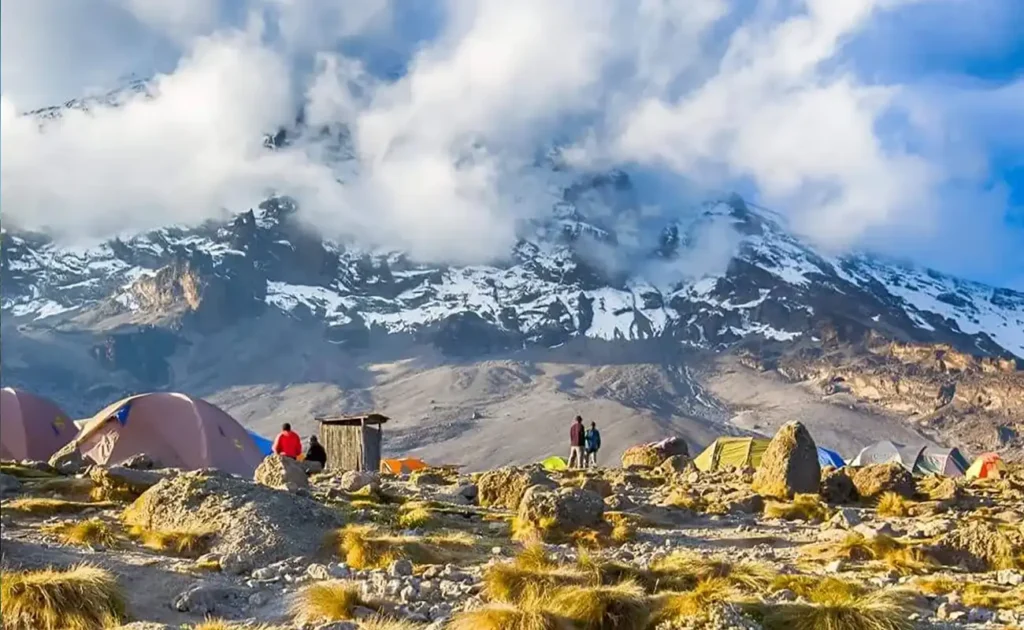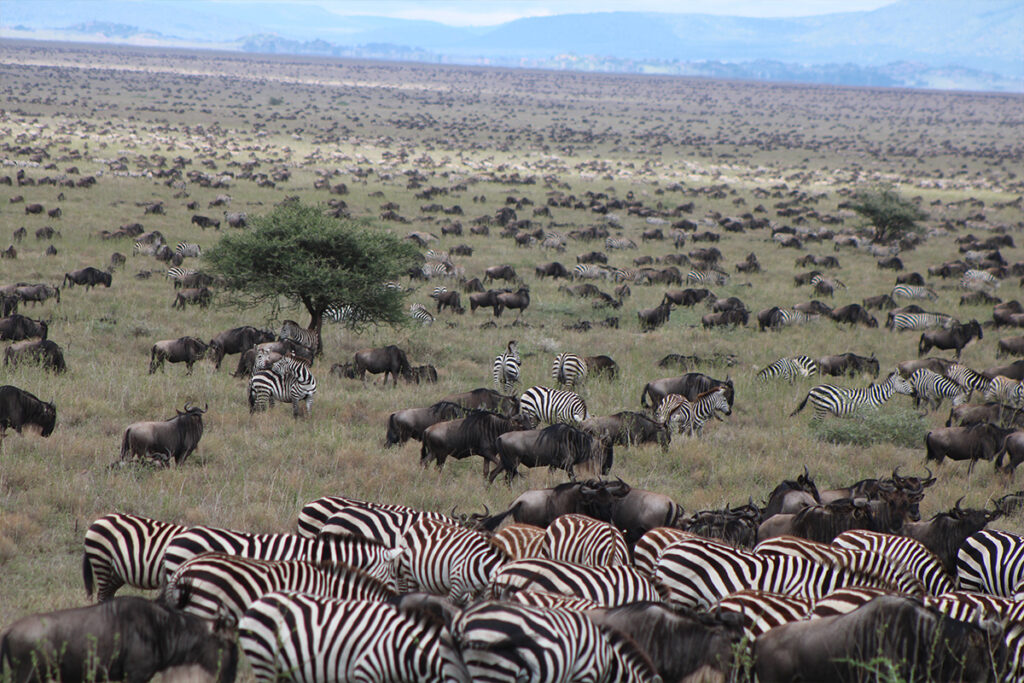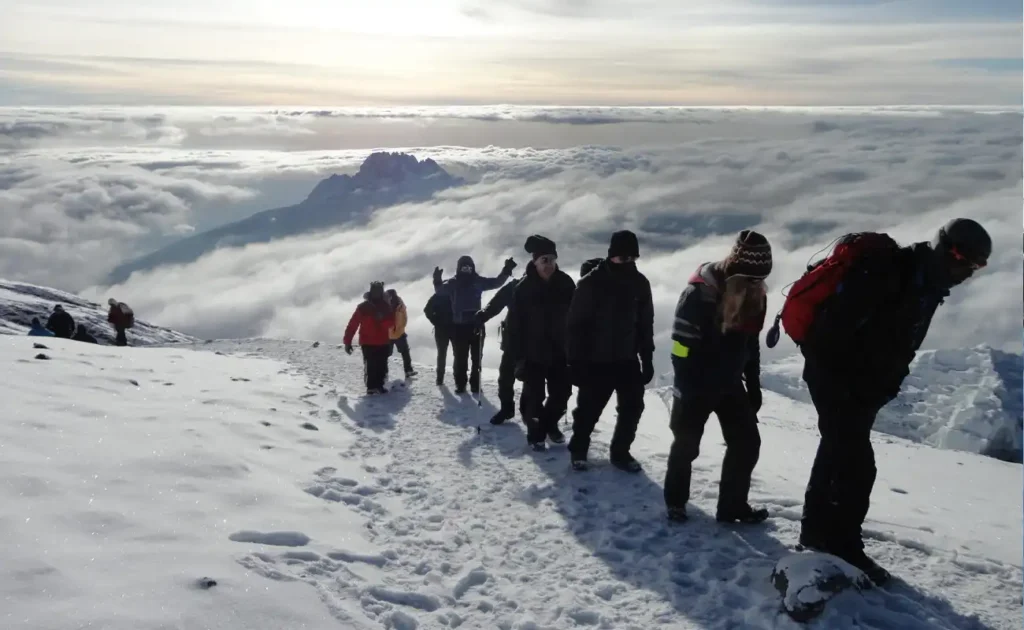Standing at an impressive 5,149 meters, Mawenzi Peak is often overshadowed by its more famous sibling, Kibo. This rugged, volcanic summit offers a thrilling challenge for avid climbers, with its sheer cliffs and sharp ridges. It’s a destination that demands respect and preparation, drawing those who seek an adventure beyond the ordinary.
Historically, Mawenzi Peak has been a beacon for explorers since the earliest days of Kilimanjaro’s discovery. The peak’s jagged and eroded terrain provides a stark contrast to the smooth, snow-capped dome of Kibo. Despite its lesser height, Mawenzi’s technical climbs and breathtaking views make it a pinnacle of fascination in the mountaineering community.

Mawenzi Peak: The Second Summit of Kilimanjaro
Mawenzi Peak is the often overlooked sibling of the taller Kibo summit. Its rugged and jagged form casts a dramatic silhouette against the sky. Though not the highest, it presents a thrilling adventure for climbers. Reaching 5,149 meters, it demands both skill and endurance. Each year, its challenging terrain attracts enthusiasts seeking more than just a view.
The geological origins of Mawenzi are fascinating. Formed from volcanic activity, its sharp peaks are what remains of an ancient eruption. This landscape is dotted with steep ridges and deep valleys. Such features make it unique compared to smoother summits. Climbers need to navigate carefully through its rocky terrain.
Visitors to Mawenzi often marvel at its diverse ecosystem. Despite harsh conditions, various plants and animals thrive here. Hardy lichens cling to its rocks, providing essential food for small creatures. Birdwatchers may spot rare species adapting to the altitude. The peak offers a glimpse into nature’s resilience.
While Kibo often takes the spotlight, Mawenzi holds its own allure. Its challenging routes and breathtaking views make it a worthy goal. For those who reach the top, the reward is not just in the scenery. They leave with a story of courage and accomplishment. Indeed, Mawenzi offers a journey as memorable as any on Kilimanjaro.
Mawenzi Peak on Kilimanjaro
Unveiling the Grandeur and Mystery
Mawenzi Peak, with its rugged beauty, sits shrouded in mystery and allure. Many climbers are drawn to its unpredictable challenges and breathtaking vistas. The peak’s jagged edges tell the tale of a volcanic past. This adds to its unique and dramatic landscape. It stands as a testament to nature’s power and creativity.
Unlike Kibo, known for its gentle slopes, Mawenzi’s sharp ridges require careful planning and skill. The Peak offers routes that test both courage and technique. These routes include the intricate “Northeast Ridge” known for its steep ascent.
- Northeast Ridge
- Technical Traverse
Many climbers find each trail as rewarding as it is challenging.
Mystery often surrounds the wildlife found in Mawenzi’s unique ecosystem. Despite harsh conditions, some plants and animals adapt incredibly well. Alpine plant species, like Helichrysum, add color to the barren slopes. There are also unique birds that nest here, making it a haven for ornithologists. Observing such life at high altitudes adds a sense of wonder to the climb.
The grandeur of Mawenzi is not just in its height. It’s in the blend of challenge and surprise it offers every adventurer. With each step, climbers uncover secrets etched in stone and sky. The experience of climbing Mawenzi Peak inspires tales of adventure and discovery. It leaves an indelible mark on all who dare to explore its mysteries.
The Geological Formation of Mawenzi Peak
The formation of Mawenzi Peak is a tale of volcanic activity that dates back millions of years. This peak is a remnant of an early volcanic cone. When Kilimanjaro was formed, there were three major cones: Kibo, Mawenzi, and Shira. Lava, ash, and other volcanic materials shaped these peaks over time. Mawenzi’s rough, jagged features are a result of severe erosion.
Despite its age, Mawenzi still exhibits signs of its fiery origin. The rocks found here are mostly trachyte, a type of volcanic rock. Trachyte formations speak volumes about the once-active volcanic nature of the region.
Table:
| Cone | Rock Type |
|---|---|
| Mawenzi | Trachyte |
| Kibo | Basalt |
Such features make it a point of interest for geologists and adventure seekers.
Erosion has played a significant role in shaping Mawenzi. Wind, rain, and ice have carved its sharp peaks and deep valleys. Over time, this natural wear has given Mawenzi its dramatic and rugged look. Today, the steep cliffs and challenging routes are a climber’s dream. These features also provide insight into the geological processes that formed the entire Kilimanjaro complex.
Intriguingly, Mawenzi’s structure continues to change. Future generations may see a different landscape as natural forces continue to sculpt the peak. This constant transformation keeps the mountain fascinating. Scientists and climbers alike find it continually rewarding. Exploring Mawenzi is akin to stepping into a dynamic, ever-evolving world.
Mountain Climbing Challenges at Mawenzi
Mawenzi Peak offers one of the most thrilling mountain climbing experiences on Kilimanjaro. Its sharp ridges and steep cliffs require climbers to be well-prepared. Unlike the gentler paths found on Kibo, Mawenzi demands technical skills.
- Proper climbing gear
- Experience in technical climbing
- Strong physical fitness
These essentials are crucial for anyone attempting this peak.
Weather conditions at Mawenzi can change rapidly, adding to the challenge. Cold winds sweep across the ridges, while sudden rain showers make the rocks slippery. This unpredictability requires climbers to be adaptable and cautious. Planning and equipment play a crucial role in safety. Knowing the weather forecasts before starting the ascent is always wise.
The altitude of Mawenzi presents its own trials. At over 5,000 meters, the thin air makes breathing harder. Altitude sickness is a real concern, even for experienced climbers. Acclimatization is vital to avoid severe health issues. Spending extra days at lower elevations can help the body adjust to the altitude.
Navigating the peak requires more than just physical strength. The intricate paths and rock formations test mental endurance too. Climbers need to concentrate and make quick decisions. Every step demands focus and determination. This mental challenge is part of what makes conquering Mawenzi so rewarding.
Due to these challenges, climbers often rely on experienced guides. Guides can provide critical knowledge about the safest routes and emergency procedures. Their expertise is indispensable in navigating Mawenzi’s complex terrain. Hiring a guide enhances safety and increases the chances of a successful climb. Many climbers find their guidance invaluable during the journey.
Despite the difficulties, reaching the summit of Mawenzi offers a profound sense of achievement. The journey is both physically and mentally demanding, but the views are unparalleled. It’s a challenging ascent that leaves climbers with a memorable adventure. Overcoming Mawenzi’s obstacles is a testament to human resilience. Many adventurers find the effort absolutely worthwhile.
The Wildlife and Vegetation of Mawenzi Area
The Mawenzi area on Kilimanjaro boasts a unique ecosystem. Here, life has adapted to the harsh conditions, creating a fascinating environment. Despite the challenging climate, a variety of plants and animals thrive. This biodiversity adds to the peak’s allure. For climbers, observing these species can be an intriguing part of the journey.
The vegetation in Mawenzi ranges from hardy alpine plants to colorful flowers. Species like Helichrysum and Lobelia grow on its slopes. These plants are well-adapted to the altitude and cold temperatures. Table:
| Plant Species | Adaptation |
|---|---|
| Helichrysum | Heat retention |
| Lobelia | Water storage |
Their unique adaptations are key to their survival at high elevations.
Animal life, though less abundant, is equally intriguing. Various birds, such as the alpine chat, can be spotted here. They are experts at surviving the thin, cold air. Small mammals also make their home on Mawenzi, though they are more elusive. Their presence adds life to the otherwise barren landscape.
Insects, often overlooked, play an essential role in this ecosystem. Beetles and butterflies can be seen fluttering among the plants. These insects help pollinate the flowers, ensuring the plants’ reproduction. They are a vital part of the food chain, supporting larger animals. Their resilience is remarkable.
This area’s ecosystem reflects the delicate balance of nature. Each species, plant or animal, plays a role in maintaining this balance. Observing them offers a deeper appreciation for the planet’s biodiversity. Mawenzi’s ecosystem is a testament to life’s tenacity. Every visit uncovers new layers of wonder in this unique habitat.
Mawenzi Peak in the Shadow of Kibo
While Mawenzi Peak stands tall as a remarkable feature of Kilimanjaro, it often lives in the shadow of the grander Kibo. Kibo’s iconic snow-capped dome dominates the skyline, capturing most visitors’ attention. Yet, Mawenzi offers a rugged, dramatic landscape that is beloved by many climbers. This peak has its own unique allure. Despite being less famous, it holds a special place in the hearts of adventurers.
The contrast between Mawenzi and Kibo is striking. Kibo boasts gentle slopes and wide paths, inviting a steady climb to the summit. In comparison, Mawenzi is more jagged with technical routes that test climbers’ skills. Table:
| Feature | Kibo | Mawenzi |
|---|---|---|
| Terrain | Smooth slopes | Jagged ridges |
| Accessibility | Popular routes | Technical climbs |
Each offers a distinct experience, appealing to different types of mountaineers.
Even climbers gravitating towards Kibo often admire Mawenzi’s moody profile from a distance. Its silhouette is especially stunning during sunrise and sunset. The shifting colors create breathtaking views. Many stop to capture photographs or simply enjoy the scene. These moments contribute to the mountain’s quiet charm.
Despite its lesser status, Mawenzi offers invaluable lessons in mountaineering. Climbers who tackle its heights gain respect for challenging terrains and technical climbs. The skills honed here are valuable for future expeditions. Resources like knowledgeable guides further enhance the experience. Every ascent leaves climbers better prepared for other peaks.
Interest in Mawenzi has grown over time, thanks to daring adventurers sharing stories of their exploits. Social media has amplified these tales, sparking curiosity among new hikers. The peak remains a symbol of adventure and resilience. It’s a reminder that even in the shadow of giants, there is greatness. Mawenzi continues to capture imaginations worldwide.
Key Takeaways
- Mawenzi Peak is Kilimanjaro’s second highest point.
- It features rugged terrain and steep cliffs for climbing.
- Climbers need technical skills due to challenging routes.
- Mawenzi offers contrasting scenery compared to Kibo’s slopes.
- The peak is key in studying Kilimanjaro’s geological past.




